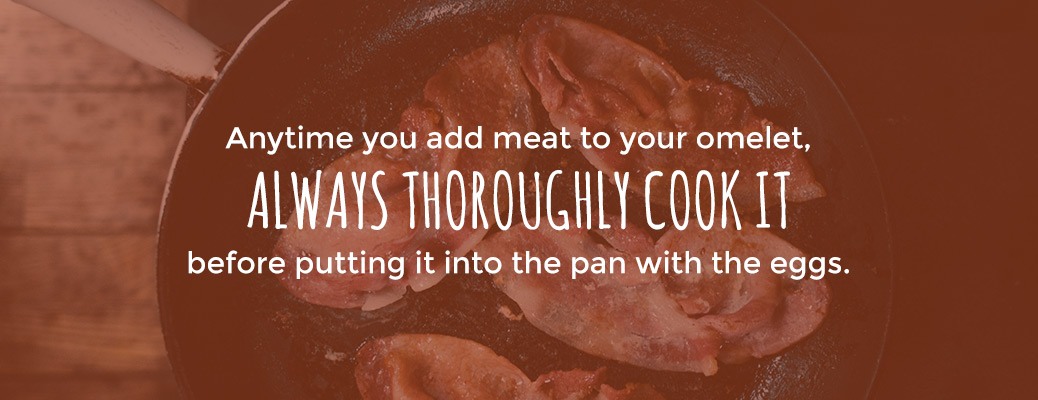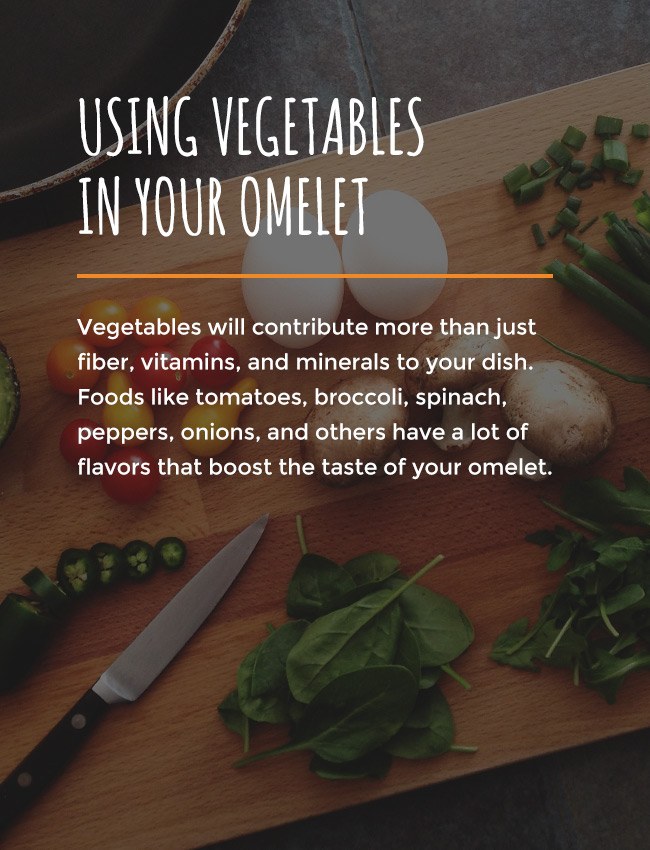How To Make An Omelet
Posted on: August 23rd 2019

Knowing how to cook an omelet can make lazy Sunday brunches and fast weeknight dinners both easier. This dish adapts well to any added ingredients, so you can make it as simple or as fancy as you like. With just a few ingredients, you have a centerpiece of a meal most only expect from a restaurant. Forget everything you’ve heard about cooking this egg recipe. Making an omelet easier than you think. Make now the time you boost your kitchen skills by learning the easy approach to this recipe.
About the Omelet

How do you enjoy your eggs? If you like your omelets on the sweet side, you can thank the Romans for that invention. Supposedly, the first form of this egg dish came from ancient Rome, where cooks mixed honey into the beaten eggs, naming the food ovemele, which means eggs and honey. While the word ovemele resembles the modern one, another possible origin for the name of the dish arises in France.
The French word for blade, amelette, more closely approaches the alternative spelling of omelette that some people use. But why use this word to refer to an egg-based dish? The semi-circular shape of a folded omelet resembles a curved ax blade, so some people may have started using the French word for the recipe.
Regardless of its origins, egg-based dishes that incorporate other ingredients into them exist around the world. In India, you can enjoy an omelet pav — a green chile-spiked omelet served on a soft and chewy bun of Portuguese origin.
The well-known Denver, or western, omelet similarly started life as an egg sandwich between pieces of bread. Chinese immigrants working on the railroad likely prepared their egg-based dishes from home using local ingredients to create a lunch for hungry workers. Egg foo young remains a favorite eggy dish at Chinese-American restaurants.
Italians enjoy frittata. This pan-cooked dish includes heartier ingredients, making it impossible to fold the finished product. All the ingredients cook slowly in the pan at the same time in a frittata. Omelets, though, have cooked ingredients folded into the center.
If you’re in Japan, you may enjoy tamagoyaki for breakfast instead of scrambled eggs. Using a rectangular pan designed for cooking the dish, a cook fries up thin layers of eggs and rolls them into a bundle. The chef then slices the log into sections for serving. Tamagoyaki appear on breakfast tables and in bento boxes at lunch and can be sweet or savory.
The ubiquity of eggs and the ease of preparing them with whatever ingredients you have on hand in only 10 to 15 minutes make omelets an ideal choice for any meal of the day no matter where you are in the world.
How to Cook an Omelet
What if you could learn how to make an omelet easily? This dish does not need to be complicated. And the more practice you get at making omelets, the easier it becomes to master the technique. Having the right equipment also helps you to get the perfect product from your efforts. Before you start on your culinary adventure, gather all your materials first. Having these on hand will make the process faster and easier.
1. The Equipment
To prepare any egg dish, you need a few pieces of equipment. Luckily, omelets don’t require any special devices to make. You only need a pan, spatula, whisk, and bowl to get started on your recipe.
While some kitchen stores will sell you pans specially made for preparing omelets, you don’t need to buy one of these. Any round pan with gently sloping sides will suffice to prepare this dish. You don’t need to use a nonstick pan, but you may find it easier to cook the recipe in one. If you properly heat a regular pan and use plenty of butter for coating, your eggs should not stick.

The pan size depends on how many eggs you cook. For individual servings, use a seven- to 10-inch pan. If you want to make a more substantial dish for a crowd, such as a frittata that requires between six and 12 eggs, select a bigger, 10- to 12-inch pan. Regardless of the size, use a round pan with curved edges to make turning the omelet easier. If preparing Japanese-style tamagoyaki, use a rectangular pan to get the eggs in a shape you can roll into a log. However, the dish will still taste just as good if you make it in a round pan.
For a spatula, the type you use depends on the pan. If cooking with a nonstick pan, avoid metal spatulas, which can scratch the delicate coating. Select a plastic or silicone spatula instead. Metal utensils will suffice for standard cookware.
For a whisk, it must fit into the bowl you stir the eggs in. As long as the utensil thoroughly breaks up and mixes the eggs, it will work. If you don’t have a whisk, use a fork in a pinch, but stir a little longer until you thoroughly break up the yolks and combine them with the whites. Once you have all the equipment you need, gather together the ingredients.
2. The Ingredients
The ingredients used to make the base include eggs, salt, pepper, water or milk, and optional butter. Beyond these, you have numerous filling options.
Choose high-quality eggs that have a flavor to shine through the dish. Even with the addition of fillings, you should still taste the richness of the eggs. If you prefer the omelet to serve as the backdrop for the added ingredient to be the star, consider incorporating liquid to the beaten eggs.
Whether to add water, milk, or nothing to the beaten eggs for an omelet is controversial. Cooking without added liquid creates a rich dish with a deep color and flavor. Adding water creates steam when cooked in a hot pan, leavening the recipe to create a fluffier, though blander creation. If you choose milk instead of water, you still get the fluffiness from steam, but it still does not taste as robust as when you prepare your entrée without liquid. The method you choose depends on your personal tastes.
Even if you cook in nonstick cookware, butter in the pan prevents the eggs from sticking while adding flavor and keeping the texture palatable. If you want to use nonstick spray or oil instead for a healthier alternative, keep in mind the taste will not be the same as if you used butter.

3. The Technique
More important than the equipment and ingredients is the technique you use. Even if you think you know how to make an omelet, you may not be using the best methods to get top results. You need to remember several things when preparing your dish if you want a flavorful, folded egg-based dish for a meal:
- Thoroughly whisk the essential ingredients in a separate bowl.
- Prepare the filling ingredients before heating the pan. Cook out most of the water from greens, mushrooms, and other wet ingredients.
- Heat the pan on medium heat until the butter melts completely and no longer foams. Tilt the pan, so the butter evenly coats the bottom before adding the beaten eggs.
- Keep the eggs moving in the pan, so no part overcooks or undercooks. Push cooked portions toward the center, allowing uncooked components to flow under and touch the pan’s surface.
- Limit fillings to two tablespoons for a two-egg omelet to prevent the eggs from tearing when you fold them over the filling.
- Add extra ingredients on one side of the eggs once the top appears cooked.
- Fold the half without fillings over the filled portion.
- Slide the finished omelet onto a plate.
If your omelet breaks when folding, your pan may be too large, creating a food that is too thin to stand up to movement. Also, don’t overfill the dish. Using too many spoons of ingredients in the middle will make it difficult for the eggs to keep their shape when folded over them.

Of course, making an omelet is only part of the enjoyment of the experience. People choose this dish over scrambled eggs for the filling options in the former. The fillings are where you can experiment with different combinations of flavors. Just remember not to overdo the amount you use to keep the dish’s shape.
Variations on a Classic Dish
The classic omelet can be a simple dish or a gourmet meal. Fillings make the difference. For heartier fare, opt for protein-packed meats or cheeses. Don’t neglect the healthfulness and flavor of vegetables, though. Sauces give your meal the perfect finishing touch.
1. Meat Options

Anytime you add meat to your omelet, always thoroughly cook it before putting it into the pan with the eggs. This preparation is especially needed for bacon and sausage, which can make you ill if not cooked thoroughly. If you only want a single serving, cook several slices of bacon or a quarter pound ground sausage and refrigerate the leftovers in a sealed container to use later. Warm any refrigerated meat before incorporating it into an omelet.
Bacon does not have to be a side dish for breakfast. Add crumbled cooked bacon into the filling for your next omelet. This recipe for bacon, mushroom, and cheese omelets uses three slices of bacon per serving. It’s a dish for true pork lovers. Roasted mushrooms boost the meatiness of the food while helping to enhance its healthfulness. Mozzarella cheese rounds out the meatiness with a mild, creamy taste.
If you can’t decide between sausage and chicken for your filling, don’t. Our recipe for a chicken and sausage omelet incorporates both into a hearty main dish for a weekend brunch. Chicken, sausage, and cheese combine in this dish to make it a protein-packed wonder with 100 grams of protein in the four-serving recipe. Make this meal for a savory alternative to protein powders or pastries for your breakfast.
A ham and cheese filling transforms your favorite sandwich lunch into a tasty breakfast. This recipe, however, skips the sliced American cheese and uses a flavorful Italian cheese blend and healthy spinach, instead. Feel free to adapt the cheese as you see fit. You can even serve this omelet between slices of toast for a portable breakfast you can eat on the way to school or work.
Satisfy your sausage cravings with a pork sausage and cheddar omelet. This stick-to-your-ribs recipe is an ideal brunch for a cold winter morning or when you need something hearty to get you through a tough morning. It uses a full pound of pork sausage and a dozen eggs for four servings. Following this recipe, you can feed your whole family with just a pair of omelets. Yellow and green onions and cheddar cheese further enhance the flavor of this dish without overwhelming the taste of the eggs and sausage.
While meats offer heartiness, not everyone wants a meat-based dish. Cheese fillings are vegetarian options for when you want rich flavor without the meat.
2. Cheese Choices

The world has hundreds of cheeses available, and you can use many of them in your omelet recipes. When it comes to the best cheeses, try those that you enjoy the flavor of when melted or warmed. The cheese should also complement the taste of the other ingredients in the filling. Knowing the flavor profiles and textures of typical cheeses will help you choose the right ones for your omelet.
- American: American cheese is best known for use on sandwiches and has a mild, unobtrusive flavor that pairs well with other ingredients. The combination of ingredients makes American good for melting.
- Cheddar: Cheddar has a creamy texture and a sharp bite that gets sharper with age. A little bit of extra sharp cheddar contributes a lot of flavor, so you can use less if you want to cut back on added dairy products.
- Colby Jack: Colby Jack combines the mellow Colby cheese with Monterey Jack for a spotted orange and white cheese that melts well.
- Feta: Crumbly feta often has a salty, tangy flavor. It can come from cow’s or goat’s milk.
- Gruyere: Nutty and savory, Gruyere is a quality choice when you want an extra rich taste without an overwhelming cheese.
- Havarti: For a buttery, sweet cheese, select a young Havarti. This cheese’s flavor sharpens with aging.
- Monterey Jack: Mild-tasting Monterey Jack has a buttery taste on its own. Because it’s so mild, it often mixes with other cheeses or flavors.
- Mozzarella: Creamy and smooth, mozzarella cheese has an association with pizza, but this fresh cheese contributes a rich creaminess to omelets, too.
- Parmesan: Parmesan cheese has a distinctively nutty, salty flavor. Grated or shaved, it adds a lot of character with a small sprinkling.
- Pepper Jack: For a kick, try pepper jack cheese. This variety combines Monterey Jack with peppers to create a mellow cheese with the bite of peppers. Use this type in Southwestern-inspired omelets or when you just want a little spice.
- Swiss: Swiss cheese features a nutty sweetness not found in other cheeses. This cheese enhances the creaminess of your dish.
3. Vegetable Variety

Vegetables will contribute more than just fiber, vitamins, and minerals to your dish. Foods like tomatoes, broccoli, spinach, peppers, onions, and others have a lot of flavors that boost the taste of your omelet. They also brighten the dish with their vibrant colors, making your recipe a feast for the eyes as well as the palate.
When using any vegetables for fillings, cook them enough to remove most of the water from them. For foods such as tomatoes, spinach, and mushrooms, cooking out the liquid is essential to preventing your omelet from becoming a watery mess. Cooking vegetables before using them as filling also condenses the flavors down, making them taste richer.
Roasted mushrooms can be a star or an accompaniment to other fillings. Use roasted mushrooms to bring out the meatiness of bacon. Or omit the bacon or substitute it for your favorite vegetarian alternative for a meatless option.
Green bell peppers and onions are such flavorful additions. They appear in many omelet recipes, including the well-known Denver omelet. Chopping these and adding them into your filling contributes flavor without a lot of spice because green peppers have the alternative name of sweet peppers. If you want a bigger kick, replace the bell peppers with your favorite green chile.
Roasted tomatoes are a tastier, less watery alternative to fresh tomatoes. If you need to cook tomatoes for dinner, add some extras in the pan and save those for an omelet the next morning. The richer, more concentrated flavor of the roasted tomatoes will ensure you won’t go back to using fresh again.
In fact, almost any vegetable you cook for dinner can go into omelets. Corn, peas, carrots, or zucchini all make tasty fillings for your breakfast. Make sure to chop the vegetables to a consistent size, so they heat evenly. If using leftovers, reheat them thoroughly before adding them to your omelet.
Vegetables are not the only foods you can add to omelets. Remember the Romans’ version of adding honey? You can make your favorite savory breakfast into a sweet dessert. Apple cinnamon omelets take the concept of apple pie and turn it on its head by using an eggy exterior instead of pie crust. This recipe works well thanks to the neutral flavor of eggs that allow for such versatility.
While fruits and vegetables contribute to the flavor, you may want to really wow those you serve with a sauce-covered dish. Though not required, sauces take your omelet to the next level.
4. Sauce Selections

Sauces contribute flavor and moisture to otherwise lackluster dishes. If you use quality eggs, your omelet will be flavorful enough to stand on its own. However, you may want a little something extra special for your recipe and adding a sauce can do just that.
Hollandaise is a classic sauce poured over poached eggs atop English muffins in eggs benedict. Chef Emeril Lagasse takes the idea of hollandaise sauce over eggs to the next level with his recipe for a crab meat omelet covered in tasso hollandaise. Tabasco sauce and tasso sausage spike the traditional creamy hollandaise sauce that tops the crab-filled eggs in this recipe.
A spicy sauce is as close as your pantry. If you have a jar of salsa, heat it and pour it over your morning omelet. You’ll get a fast, simple way to add moisture and the flavor of onions, peppers, and tomatoes to the dish. Prepared pesto can do the same thing. Almost any pre-made sauce for topping you have in your kitchen from alfredo to marinara sauce can cover an omelet.
The beauty of omelets is how versatile they are. They adapt well to whatever ingredients you have in your kitchen, whether they’re leftovers, freshly prepared, or from a jar. You can even make sweet or savory variations on the dish. The next time you get stumped for dinner or crave something filling for breakfast, reach for the eggs in your refrigerator, and prepare an omelet.
Try Sauder Eggs for Your Next Omelet
Because eggs make such a large part of omelets, any recipe you prepare should start with quality, fresh eggs. Find Sauder Eggs at your local market using our online store locator. Getting farm-fresh eggs is as easy as a trip to the grocer.

